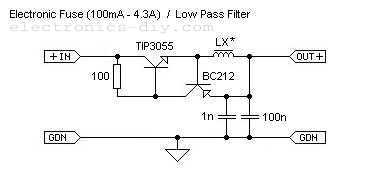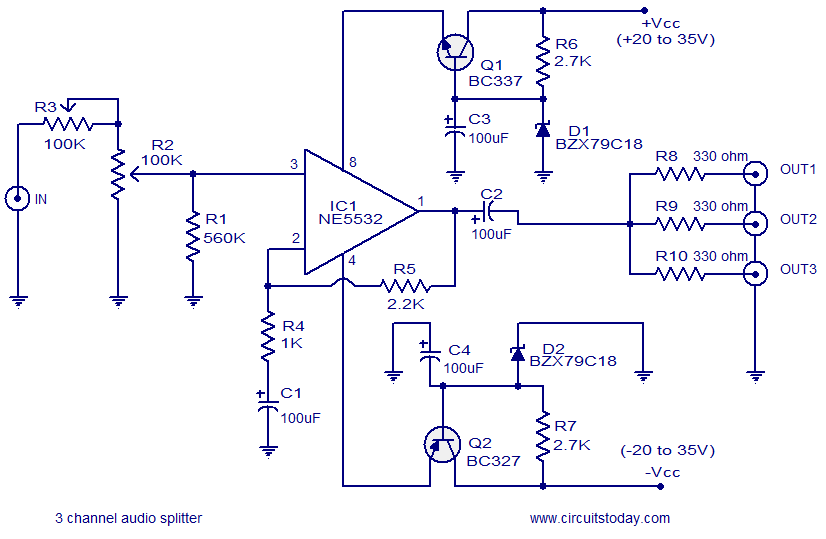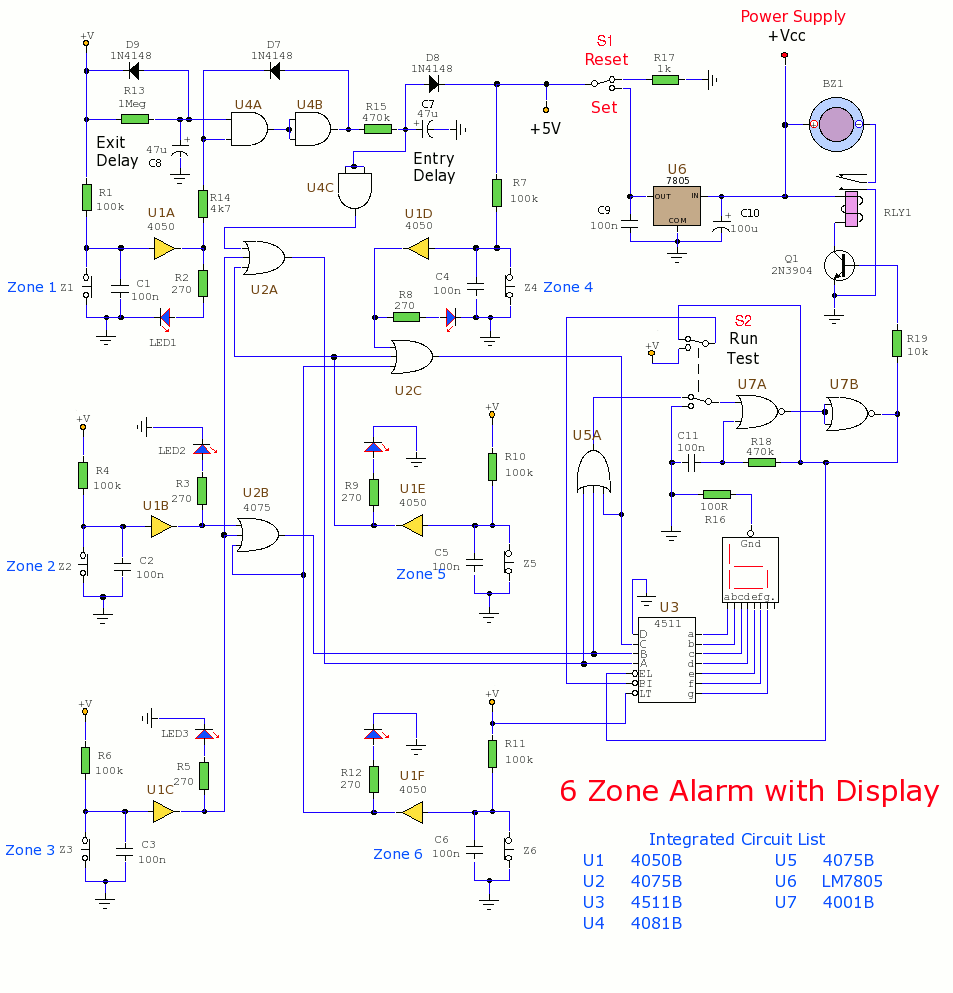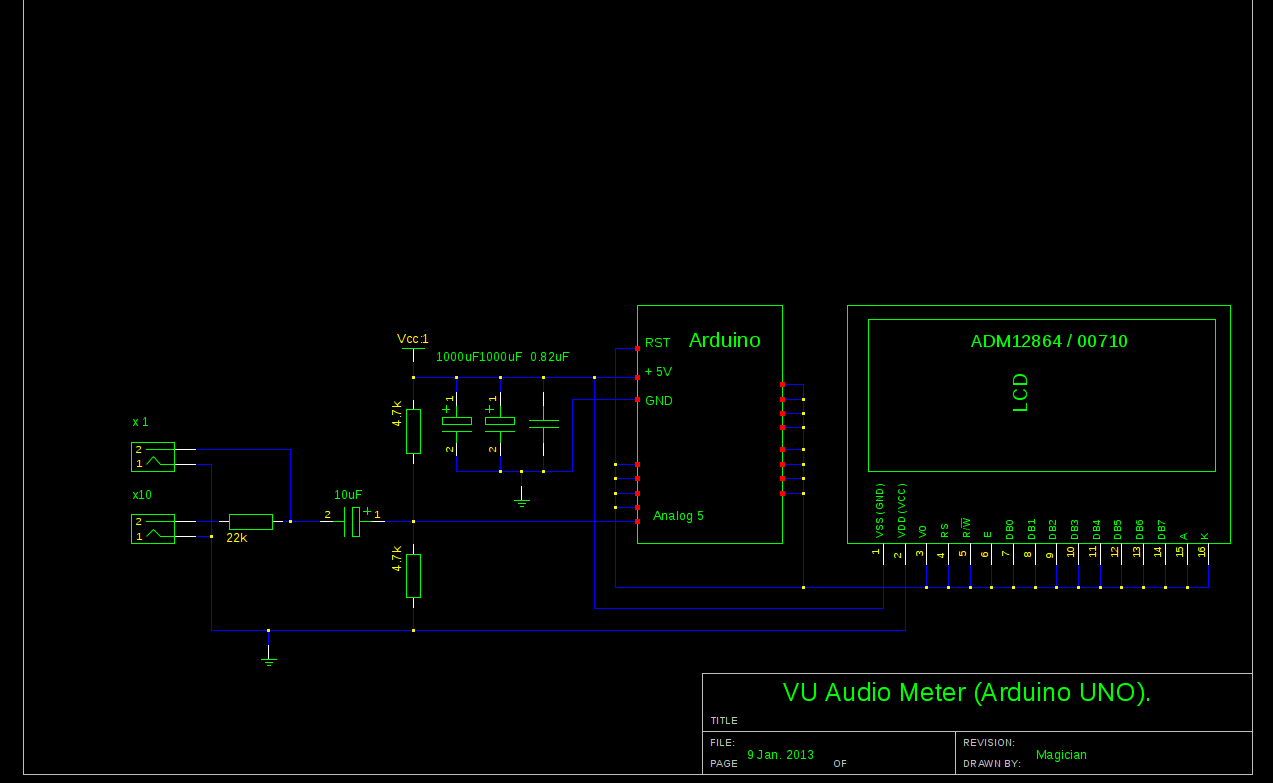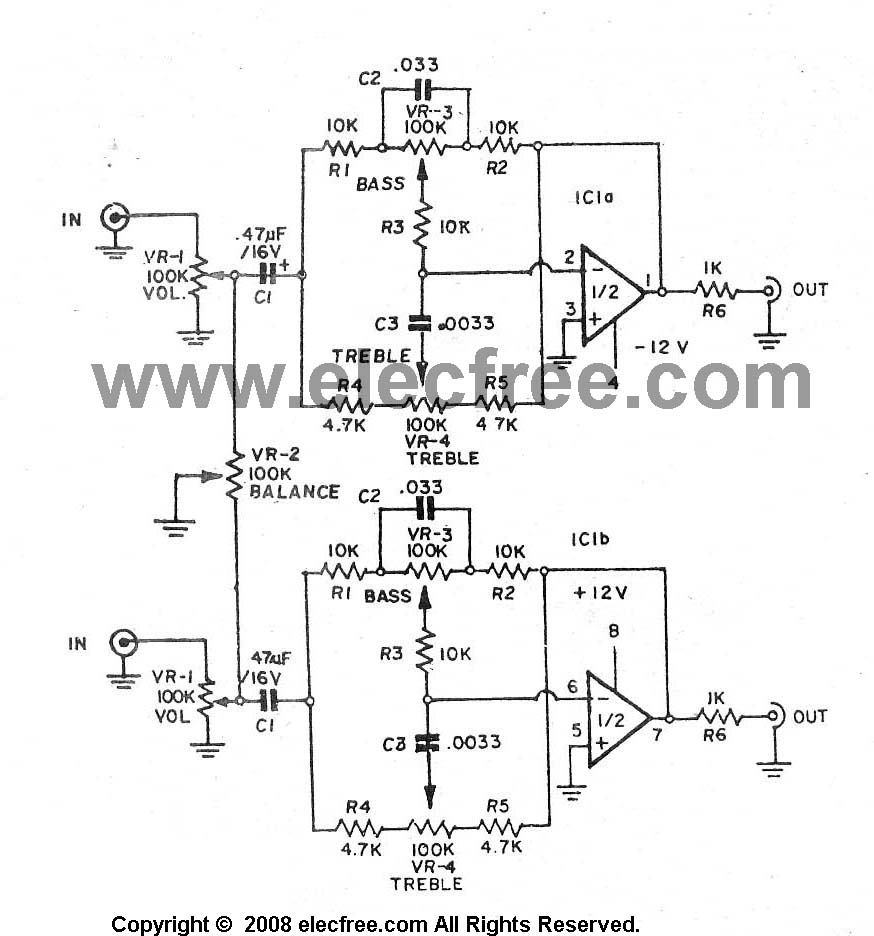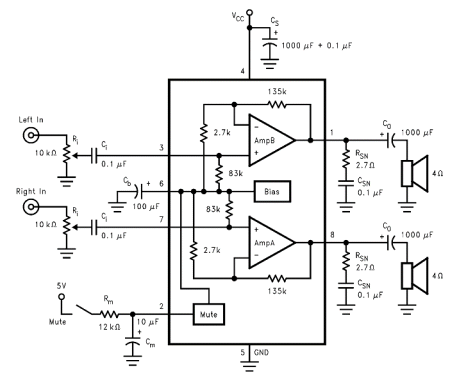
Audio noise filter circuits
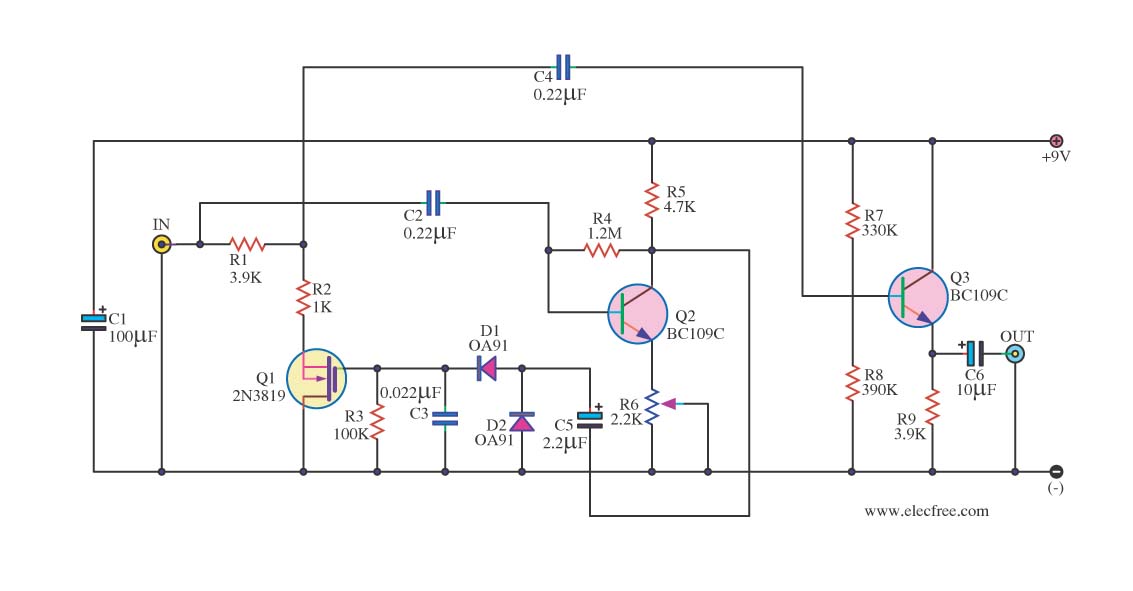
In audio systems, noise signals are generally undesirable, and efforts are often made to eliminate them. Transistors can be utilized effectively for this purpose due to their availability and low noise characteristics. The following circuit serves as a Noise Filter Circuit designed to filter out disturbing frequencies. It employs FET transistor number 2N3819 and requires minimal additional electronic components. This circuit can effectively reduce high-frequency signals above 20 kHz, making it suitable for sound applications, while also allowing for fine-tuning of noise levels. The band rejection filter circuit is designed to attenuate frequencies by up to 60 dB, utilizing the TL071 single-chip operational amplifier, which exhibits very low distortion and operates effectively up to 100 kHz, covering the range of 1 Hz to 20 kHz. In this circuit, three resistors (R1, R2, R3) are set to 100 kΩ, and two capacitors (C1, C2) are each 330 pF to reject frequencies around 50 Hz. The rejection can exceed 40 dB if the resistors are matched to 0.1% tolerance and the capacitors to 1% tolerance. For those experiencing noise issues, this circuit may provide relief. Additionally, there is a Filter for Scratch and Rumble Noise Circuit that utilizes resistors and capacitors, commonly referred to as a Passive Filter Circuit. This circuit includes a switch for selecting the type of noise filter: SW1 for Rumble noise and SW2 for Scratch noise. The circuit minimizes noise, with a recommendation to use a 9V battery as the power supply to further reduce noise from the power source.
The Noise Filter Circuit described is an effective solution for mitigating unwanted audio interference. The choice of the 2N3819 FET transistor is strategic, as it provides a low-noise operation essential for maintaining audio fidelity. The TL071 operational amplifier is well-suited for this application due to its high input impedance and low output distortion, allowing for accurate signal processing.
The design incorporates a band rejection filter configuration, which is crucial for targeting specific frequency ranges that may introduce noise into the audio signal. The calculated values for the resistors and capacitors are critical in determining the filter's cutoff frequency and overall performance. The formula \( F = \frac{1}{2\pi RC} \) is used to derive the cutoff frequency, ensuring that the circuit effectively rejects frequencies around 50 Hz, a common range for unwanted noise.
The inclusion of a switchable feature for Rumble and Scratch noise allows users to customize the filtering process according to their specific needs. This flexibility is beneficial in various audio environments where different types of noise may be present. The recommendation to use a 9V battery as a power source is particularly important, as it helps to minimize power supply noise, which can otherwise affect the overall performance of the audio system.
In summary, this Noise Filter Circuit is a practical and efficient solution for audio applications, providing users with the ability to filter out undesirable noise while preserving the integrity of the desired audio signal.When we said to Noise signal in an audio system. everyone not likes it, wants to get rid of it all. I also not like them too. However, we can use it to get rid of it. I use transistors. Because it is easy to find. And low noise. Friends try to see the circuit below. This be Noise Filter Circuit for filter the frequency disturbs all well. By use ba se type equipment the FET transistor number 2N3819 and Electronic part The other a little again. It can be usable economize with. By the circuit will decrease frequency tall signal more 20KHz well. Then can apply in side sound circuit well, and still have still can fine decorate filter noise level has as well yes. The band rejection filter circuit is not wide filter that can denial the frequency up to 60dB by we used the TL071 single chip op-amp it is very low distortion and work good at output to maximum to 100kHz or the range 1Hz to 20kHz In the circuit we defined three resistors R1, R2, R3 are like value to 100K, and then two capacitors C1, C2 are equal to 330pF, For will reject the frequency at 50Hz.
By we can select the parts with the formula is F = 2G—3. 14xRC, And to get rejection well than 40dB if we should the resistor matched to 0. 1% and capacitor to 1%. If a friend gets into trouble about the noise. Try out this circuit before, may like. It is Filter the Scratch and Rumble Noise Circuit. That make a friend feels annoyed very the character of the circuit filters this frequency, use, Resistor, and, Capacitors, or, RC Filter that often call that Passive Filter Circuit. By have Switch choose filter the noise. By SW1 for Rumble noise Filter and the SW2 for Scratch noise filter. Make the noise that change this circuit goes to are left a little for power supply Source should use battery 9V.
Because will decrease the noise from power supply, give with this circuit there yes. 🔗 External reference
The Noise Filter Circuit described is an effective solution for mitigating unwanted audio interference. The choice of the 2N3819 FET transistor is strategic, as it provides a low-noise operation essential for maintaining audio fidelity. The TL071 operational amplifier is well-suited for this application due to its high input impedance and low output distortion, allowing for accurate signal processing.
The design incorporates a band rejection filter configuration, which is crucial for targeting specific frequency ranges that may introduce noise into the audio signal. The calculated values for the resistors and capacitors are critical in determining the filter's cutoff frequency and overall performance. The formula \( F = \frac{1}{2\pi RC} \) is used to derive the cutoff frequency, ensuring that the circuit effectively rejects frequencies around 50 Hz, a common range for unwanted noise.
The inclusion of a switchable feature for Rumble and Scratch noise allows users to customize the filtering process according to their specific needs. This flexibility is beneficial in various audio environments where different types of noise may be present. The recommendation to use a 9V battery as a power source is particularly important, as it helps to minimize power supply noise, which can otherwise affect the overall performance of the audio system.
In summary, this Noise Filter Circuit is a practical and efficient solution for audio applications, providing users with the ability to filter out undesirable noise while preserving the integrity of the desired audio signal.When we said to Noise signal in an audio system. everyone not likes it, wants to get rid of it all. I also not like them too. However, we can use it to get rid of it. I use transistors. Because it is easy to find. And low noise. Friends try to see the circuit below. This be Noise Filter Circuit for filter the frequency disturbs all well. By use ba se type equipment the FET transistor number 2N3819 and Electronic part The other a little again. It can be usable economize with. By the circuit will decrease frequency tall signal more 20KHz well. Then can apply in side sound circuit well, and still have still can fine decorate filter noise level has as well yes. The band rejection filter circuit is not wide filter that can denial the frequency up to 60dB by we used the TL071 single chip op-amp it is very low distortion and work good at output to maximum to 100kHz or the range 1Hz to 20kHz In the circuit we defined three resistors R1, R2, R3 are like value to 100K, and then two capacitors C1, C2 are equal to 330pF, For will reject the frequency at 50Hz.
By we can select the parts with the formula is F = 2G—3. 14xRC, And to get rejection well than 40dB if we should the resistor matched to 0. 1% and capacitor to 1%. If a friend gets into trouble about the noise. Try out this circuit before, may like. It is Filter the Scratch and Rumble Noise Circuit. That make a friend feels annoyed very the character of the circuit filters this frequency, use, Resistor, and, Capacitors, or, RC Filter that often call that Passive Filter Circuit. By have Switch choose filter the noise. By SW1 for Rumble noise Filter and the SW2 for Scratch noise filter. Make the noise that change this circuit goes to are left a little for power supply Source should use battery 9V.
Because will decrease the noise from power supply, give with this circuit there yes. 🔗 External reference
